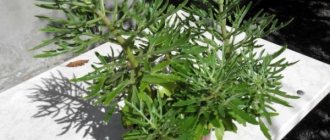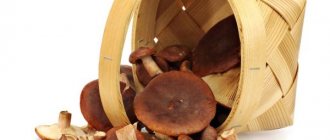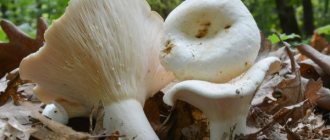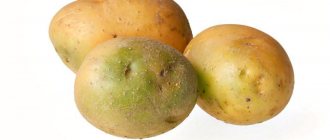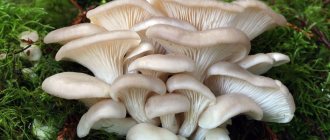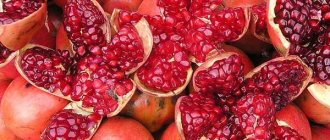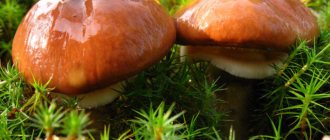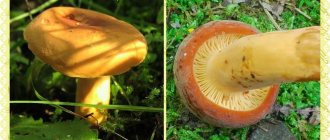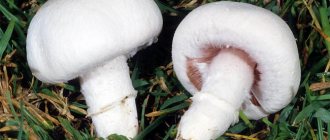5 / 5 ( 1 voice )
Lovers of quiet hunting affectionately called this species “deer horns” for its striking resemblance to this part of the animal’s body. Their branched fruiting bodies also resemble sea corals. The mushroom belongs to the category of edible species, has excellent taste, it can be salted, pickled, fried, etc. Find out how and where you can find amazing fruits in the forest, how to correctly identify them and what delicious things to cook from horned mushrooms.
Systematics, characteristics and description of the structure
Rogatik yellow belongs to the species Ramaria yellow, genus Ramaria, family Gomphova. Other names: Yellow Ramaria, Yellow Rogatik, Bear's Paw, Yellow Coral. The name in Latin is Ramaria flava.
The height of the slingshot sometimes reaches 20 cm. The diameter can be the same. The fruiting body is highly branched and consists of fleshy, sulfur-yellow or lemon-yellow branches. Later they change color to ocher or orange. The tips of the branches are blunt, with irregularly truncated ends.
Reference! If you press on the fruiting body of the hornet, a wine-brown spot will form at this place.
The pulp is fragile and has a watery consistency. Its color is light, yellowish, its smell is weak, pleasant, floury, its taste is inexpressive. As the fruiting body ages, it becomes bitter, especially in the branches.
The leg reaches 8 cm in length and 5 cm in thickness. It is painted in all shades of yellow depending on the color of the entire fruit, becoming lighter closer to the base. If pressed, it turns reddish-brown.
The spore powder is white; the spores themselves are formed on the outer surface of the mushroom.
A little history
This species was first described by the scientist Joseph de Tournefort, a French botanist, in 1755. Ramaria yellow received its binomial name thanks to Lucien Quele, the founder of the French Mycological Society, in 1888.
Answers to common questions
Mushrooms of normal shape raise a lot of questions among mushroom pickers:
When collecting any mushrooms, certain rules must be strictly observed: the crop is cut and not ripped off by the roots; The soil and moss in the forest should not be stirred up or dug up too much; picking mushrooms in nature reserves is prohibited; mass collection of any species will certainly lead to its extinction.
The rubbery pulp of kalocera has a reddish tint. The false mushroom has no taste or smell. The fruiting body has pointed branches and is dark yellow or orange. Real yellow corals are very similar to Kalocera, which are not characterized by the cartilaginous and gelatinous consistency of the fruiting body.
The coral hedgehog is one of the most unusual representatives of its family. It is famous not only for its interesting shape, but also for its good taste. But when collecting this species, you should be extremely careful, because it can easily be confused with false corals.
The world of mushrooms is truly fascinating and unique. These organisms are unique in themselves and can surprise you with their shapes, complex life cycles, and taste.
In the forests you can sometimes find an unusual mushroom that looks like coral. People call it “deer horns”. Let's talk more about these mushrooms.
Time and place of fruiting
The bear's paw prefers temperate climates. Settles on the soil in coniferous, deciduous and mixed forests. Grows singly or in small groups. Yellow horned grass can be found in the Caucasus mountains, Karelia, and Central European countries (Russia, Crimea, Belarus).
Fruiting time is August - September. It is listed in the Red Book as a rare species and is considered the highest mushroom.
Important! An older specimen of yellow ramaria begins to taste bitter, so experienced lovers of quiet hunting recommend collecting slingshots at a young age, i.e. in early August-September.
Video
False doubles
Bear's claw can be confused with similar species that are not always edible. Therefore, it makes sense to carefully study the features of the mushroom in the photo and look at the table so as not to confuse dangerous species with the harmless horned mushroom:
| Name | Differences | Edibility |
| Blunt Horntail Ramaria obtusissima | It has rounded ends of the branches and is quite bitter in taste. Found in Siberia, in mixed forests, with the presence of fir, in Far Eastern oak plantings. | Inedible |
| Yellow-brown hornet Ramaria flavobrunnescens | The height of the fruiting body does not exceed 10 cm; as they mature, dark brown spots appear on the mushrooms. | Conditionally edible |
| Golden Hornbill Ramaria aurea | It is painted in a brighter ocher-yellow color, becoming lighter closer to the base. | Conditionally edible |
| Golden-yellow horntail | A smaller fruiting body (up to 15 cm in height) is found only in the Primorsky Territory. | Conditionally edible |
| Kalocera sticky Ramaria lutea | Grows on stumps and dead wood. It has a bright egg-yellow color, dense jelly-like pulp | Yadovita |
Reference! The word flava in the name of the mushroom means “yellow”.
Rogatik reed, how to cook. Rogatik reed. – Edible mushrooms – Description of mushrooms
Although the mushroom is considered unfamiliar, in some regions it is found quite often, and even abundantly. Rogatiki are mushrooms that do not like open spaces; they often hide under the spreading arms of spruce trees. The horned mushroom is not considered a valuable mushroom, and it is precisely because of its “unpopularity” that it can lead an inexperienced mushroom picker to a nervous breakdown, in particular this applies precisely to those places where there are a lot of them. Looking under the next spruce in search of something more interesting, it is the horned birds that are discovered, tightly occupying this secluded corner, and so on almost everywhere. The stronger ones leave with a sigh, the less strong ones leave with a strong word and stomp home with an empty basket.
The fruiting body of the mushroom can reach up to 14 centimeters in length and up to 3 centimeters in diameter, somewhat thickened and flat at the top. The color of young mushrooms ranges from soft cream to pinkish; as the mushroom matures, it acquires a yellow tint. This is due to the spore-bearing layer covering the entire mushroom and the general yellow color of the spores. The flesh of the mushroom is quite dense, springy when pressed, light and dry. With age, the total mass of the pulp noticeably darkens.
The fungus is widespread in areas with a generally cool climate and predominant spruce forests with mossy soils. Friendships with other trees are difficult for the horned cattail to establish, and if in spruce forests it can be seen in whole brood colonies, then in other conditions it is rarely seen alone.
The only way to confuse the cattail is with the even rarer cattail, but this is more luck than misfortune.
Rogatiki grow at the moments of greatest fruiting of other various representatives of the mushroom world; their season is the end of July and until late autumn.
It is quite edible, but its meager qualities as a food product melt with age; the younger the horned mushroom, the tastier it is, although even at this age it is collected extremely rarely.
Medicinal properties and use of mushroom in medicine
Ramaria yellow contains beneficial amino acids methionine and tryptophan, lipids, phytoagglutinin and sterol. The latter is often used by Chinese healers to heal problems with the gastrointestinal tract, as well as to improve lung function.
It is believed that yellow hornet also has antitumor properties and strengthens the immune system. In addition, deer horn mushroom is used in cosmetology to slow down the aging process and with skin aging.
In folk medicine, bear's paw is used to make infusions to treat joints and healing decoctions to get rid of helminths and parasites.
Similar species
- Ramaria golden
Closely related and very similar species. Often, these species cannot be distinguished without microscopic analysis. However, often the golden variety has slightly shorter branches and an almost white base. The nutritional qualities of both types are identical.
- Ramaria beautiful tricolor
The slightly poisonous one is distinguished by its color (the branching part is ocher or brownish in color, and the base is pink in youth, then whitish) and the taste of the pulp, which in the tricolor species is slightly bitter.
1-Ramaria golden 2-Ramaria beautiful tricolor
Evaluation of taste, chemical composition, benefits and possible harm
Despite the fact that deer horns are classified as a fourth category mushroom due to the presence of a characteristic bitterness during the growth process, when young they are quite tasty and can be prepared in the same way as most other edible species.
Chemical composition per 100 grams of mushroom:
- 2 g protein;
- about 4.5 g fat;
- almost 3 g of carbohydrates.
Average caloric content is 55 kcal per 100 g.
The benefits of yellow ramaria include the following qualities:
- Prevention of the appearance of malignant neoplasms.
- Relieving depression and normalizing mental state.
- Strengthening blood vessels, stabilizing the functioning of the cardiovascular system.
- Getting rid of diseases of the bronchopulmonary system and respiratory organs.
- Prevention of thrombosis, normalization of blood pressure.
- Boosting immunity.
- Cleansing the body, removing toxins and breakdown products.
The main area of application of yellow corals in cosmetology is anti-aging procedures. Deer horns have the ability to retain moisture in the epithelial layers; their effectiveness is several times greater than the properties of glycerin and hyaluronic acid. The natural polysaccharides contained in the chemical composition act as conductors of beneficial substances to the deep layers of the skin, and vitamin D activates metabolic processes.
Possible harm from consumption is also present. Like any other type of mushroom, yellow hornets are prohibited from being eaten by children under 12 years of age, pregnant and lactating women, people with chronic diseases of the gastrointestinal tract and a tendency to allergic manifestations.
Let's sum it up
Rogatiki mushrooms are represented in nature by several varieties, including edible and poisonous. Edible ones have low taste due to the bitterness of the pulp, therefore they are not subject to mass procurement and are often called conditionally edible. If you intend to use them for food, it is better to turn your attention to young specimens.
They contain substances that have the properties of a natural antibiotic. If the cooking technology is violated, they can cause harm to health.
Recipes for cooking dishes from reindeer horns
The widespread practical use of mushroom corals in cooking is due to their low calorie content and rapid digestibility. Nutritionists recommend dishes made from them to those who want to lose weight and improve their health at the same time. The range of recipes and methods is extensive: yellow ramaria can be fried, boiled, pickled, pickled, cooked roast, fried with vegetables or potatoes, canned, cooked in salted form, cooked in soup, made in the form of caviar.
Primary treatment at home
To ensure the absence of bitterness, yellow ramaria is first boiled for 15–20 minutes, draining the broth or removing the ends of the branches. Forest “corals” processed in this way can be prepared like other edible mushrooms - boiled until fully cooked, fried and stewed, pickled and salted.
Interesting! True connoisseurs of mushrooms know that young deer horns are unique in dishes. Depending on the cooking method, they can resemble tender chicken breast or shrimp meat.
Cooking
Reindeer antlers should be washed and soaked in a large volume of cold water for 1 hour. Then squeeze out the fruiting body and rinse again. Cut off the hard parts of the legs with a knife. Place the fruit in a pan of boiling salted water and cook for about 10-12 minutes. Drain the mushrooms in a colander after boiling and allow excess liquid to drain. Cut into thin strips or whatever the recipe calls for and continue cooking.
Pickling
Some lovers of quiet hunting are not very fond of pickled deer horns, and this is completely in vain. This beautiful mushroom in a jar resembles real coral. In winter, pickled yellow ramaria will come in very handy; it can decorate any table!
Ingredients:
- slingshots – 1 kg;
- salt – 1 tbsp. l.;
- sugar – 1 tbsp. l.;
- vinegar – 1 tsp;
- spices: cloves, bay leaves, peppers.
Step-by-step preparation:
- Carry out preliminary preparation: soak and boil the mushrooms for 10 minutes.
- Prepare the marinade in a deep container: dilute spices, seasonings, and vinegar in 1 liter of water.
- Place mushrooms in a saucepan and boil for 30 minutes.
- Place the pickled cattails in clean, sterilized jars and fill with boiling brine.
- Seal with plastic caps and store in a cool place.
Reference! Due to their structure, reindeer horns are considered one of the dirtiest mushrooms. They should be washed at least 3 times in running water.
Frying
Preparing fried yellow cattails is not at all difficult. This is done by analogy with the methods of cooking other mushrooms. At the end, add cream or sour cream, chopped herbs or garlic to taste - the dish will sparkle with new colors.
Ingredients:
- ramaria m 500 g;
- vegetable oil – 2 tbsp;
- salt - to taste;
- onion – 1 head;
- ground black pepper - a pinch.
How to cook reindeer horns mushrooms:
- Rinse thoroughly and pre-boil the fruiting bodies in salted water for 10 minutes.
- Squeeze lightly and strain out excess liquid.
- Peel the onion, chop into small cubes, fry in oil until soft.
- Cut the bear paws into strips or cubes. Place in the pan with the onions.
- Cook with the lid closed for 10–15 minutes, season with salt and spices.
Salting method
Fans of quiet hunting strongly do not recommend adding spices and aromatic herbs when salting yellow hornets, believing that this will only destroy the wonderful smell and taste of ramaria.
Components:
- salt – 40 g;
- mushrooms – 1 kg.
How to pickle bear paws:
- Before salting, you do not need to wash the fruiting bodies, otherwise they will become saturated with moisture and become soggy. Brush the ramaria gently with a brush to remove debris and leaves from the branches.
- Place the mushrooms in layers in a suitable container, sprinkling each with salt.
- Cover the bucket or pan with clean gauze and place a heavy weight on top.
- Store the workpiece in a cool place. After 30 days you can try the mushrooms.
Drying
Young fruits of yellow ramaria can be dried. Overripe fruiting bodies sometimes rot when dried, while young ones dry out easily. To dry them, they need to be divided into the maximum possible number of branches, leaving part of the stem. The thread will be threaded through it, and in addition, this way they will be secured more securely. Next, the mushroom garlands are hung in the shade in a dry and ventilated room.
Reference! When preparing dishes from dried deer horns, the mushroom must be soaked in water for 12 hours, then rinsed thoroughly and boiled for 10 minutes.
Ramaria soup
To prepare a delicious, rich soup, you don’t need to look for expensive ingredients; everything you need is always at hand. Serve a delicious first treat with black rye bread croutons.
Ingredients:
- slingshots – 400 g;
- onion – 1 head;
- carrots – 2 pcs.;
- potatoes - 3 tubers;
- butter – 30 g;
- garlic – 2 cloves;
- dill, salt - to taste.
Cooking process:
- Boil pre-soaked ramaria fruit bodies in salted water for 20 minutes. Drain the liquid and do not use again. Some housewives claim that you can boil the horned ones twice, it will only be better.
- Peel the vegetables and cut them into small cubes. Carrots, if desired, can be chopped using a grater.
- Place all the vegetables in a large container, add boiling water, cook for 10-15 minutes over medium heat.
- Add mushrooms, which can be pre-cut into thin strips.
- Cook the soup for another 10 minutes.
- Turn off the heat, add butter, crushed garlic, chopped herbs. Season with spices and salt.
Canning for the winter in jars
Try to prepare a very tasty assorted vegetable platter with reindeer horns mushrooms. This dish can rightfully be called a delicacy, and its scope of application is very wide: an appetizer, a side dish, an addition to pasta and potatoes.
Ingredients:
- yellow ramaria – 1 kg;
- zucchini – 700 g;
- eggplants – 2 – 3 pcs.;
- pepper – half a kilogram;
- carrots – 2 pcs.;
- sweet pepper - half a kilogram;
- onions – 2 pcs.;
- nutmeg - a pinch;
- sunflower oil – 150 ml;
- salt - 1 tsp;
- apple cider vinegar – 50 ml.
Cooking process:
- Boil the horned mushrooms twice in salted water. Each time, drain the broth and fill with cold water.
- Peel all vegetables. Cut the onion into cubes, the rest of the fruits – larger ones.
- Fry mushrooms and onions in half a portion of oil.
- Fry the remaining vegetables in the remaining oil.
- Mix all ingredients in a deep container.
- Add salt and nutmeg, pour in apple cider vinegar.
- Place the mixture in clean jars and cover with lids.
- Sterilize each jar for 10 minutes in slowly boiling water. Roll it up and send it to a cool place.
Storage and freezing rules
To preserve the horned ones almost in their original form for the winter, you can freeze them. But before putting the mushrooms in the freezer, they also need to be pre-prepared: soak, boil in two waters with salt. Then the fruiting bodies are placed in a colander, the water is allowed to drain, and they are laid out in portions into containers. Each container is placed in the freezer compartment and used as needed.

